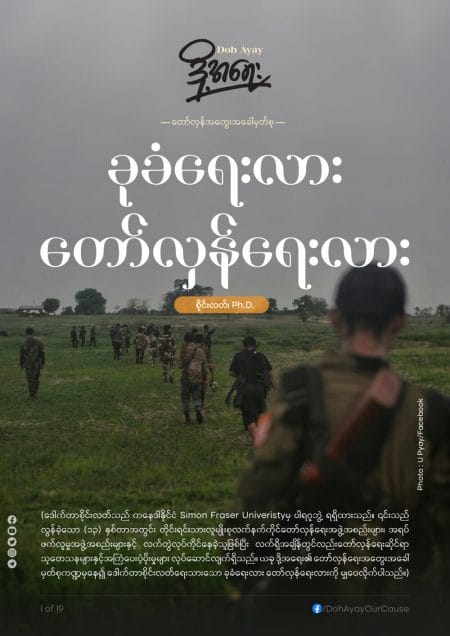This essay dissects the 2.5 years old "Myanmar Spring" (or Nway Oo or accurately "early summer revolution") in the face of the universally unpopular military coup waged on the pretext of serious voter fraud by Aung San Suu Kyi's re-elected National League for Democracy. It rightly sees the bravery and determination of Myanmar's youth as one major factor that has sustained the armed and non-violence resistance against the popularly reviled coup leader Min Aung Hlaing and his instrument of terror, the Tatmadaw or formerly revered national armed forces. It injects a healthy dose of a class analysis which is too often glossed over or simply ignored by too many Myanmar watchers, pro-NLD lobbyists and mainstream scholars and experts on Myanmar affairs.

Download the Sai Latt essay HERE
Interestingly, Dr Sai Latt's situates in the process and context both the ousted NLD regime – which it correctly sees as an instrument of national bourgeoisie (cronies and urban commercial elite) beneath the veneer of democracy, human rights and federalism – AND the still unfolding Myanmar opposition movements against the coup junta. Crucially, in an observation bound to upset many in the elite or leadership positions of Myanmar Nway Oo Revolution the author likens those Myanmar operating in the international lobby or advocacy spaces to "assembly line workers", running or attending numerous Zoom and in-person meetings, gatherings and events, repeating ad nauseum well-rehearsed spins of federalism, democracy and human rights. His empirical research coughs up the deeply troubling absence of truly revolutionary (read "principled" & progressive) thoughts and deeds, weak intellectual underpinnings – beyond recycling and relaying of worn-out but still popular catch phrases and views – and the absence of clarity of revolutionary goals, if at all.
Up-close, but not personal, this truly critical Burmese scholar-practitioner sheds a crucial light, without fear or favour, on the dark spaces where Nway Oo is failing to deliver – intellectual, ideological and real-life revolutionary gains. In the 19-page analysis, Dr Sai Latt makes those of us who are engaged in and supportive of Myanmar resistance to look objectively and honestly at the very movement (s) which seeks to overthrow the universally hated Common Enemy. He asks whether the current movements – termed Taw Hlan Yay or "revolution" in Myanmar language – are engaged in merely an attempt by any means to put the old neo-liberal NLD leadership back in power or do they actually have any serious revolutionary or progressive mission anchored in revolutionary ideals and informed by the understanding of the political economy of the global capitalist regime with its national offshoots in places like Myanmar, a raw material supplier and a source of cheap labour.
About the author
Sai Latt
PhD (geography), Simon Frazer University, Canada.

No comments:
Post a Comment